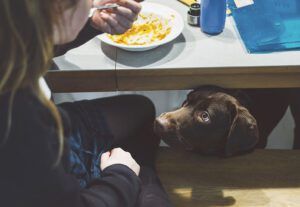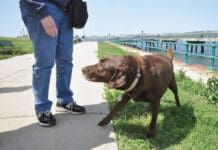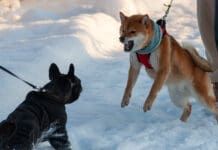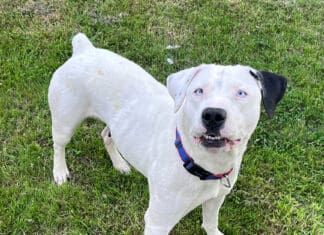It’s natural for dogs to want to share our tasty food. Their sense of smell is thousands of times more powerful than ours; our food must smell irresistible. So they whine, paw at us, “sit pretty” with bright eyes – anything they can think of to get our attention, in hopes that we will share your food with them. It’s sort of cute – but the begging for food behavior can get so over-the-top that you can’t enjoy your meal in peace!
Don’t despair; behavior is almost always modifiable. The chances are good that you can teach your dog to do something that’s more acceptable to you while you’re eating – as long as the begging behavior isn’t being reinforced by a family member who surreptitiously slips bits of food to her when you’re not looking.
Manage the Situation
To change your dog’s behavior around food, first you’ll need to change some human behavior. Everyone in the household (including visitors!) needs to refrain from feeding the dog during the family’s meals, whether it’s served at the dining room table or consumed while watching TV from the couch. If you can’t trust everyone to comply, you’ll need to secure your dog somewhere away from the dining area, or your no-begging aspirations are toast.
To allay feelings of guilt over your perhaps hungry dog, feed her dinner before you eat yours. Then, until you teach her a new dinner behavior, put her in another room, a crate or exercise pen, or tether her away from your eating area. Give her a long-lasting chew of some sort to keep her engaged and happy while you eat in peace.
Train a Different Behavior
It’s perfectly okay to stop there – to simply prevent her from having an opportunity to beg – without taking further steps to modify her behavior.
But if you’d like to work on changing her behavior around your family’s food, your best approach is to reinforce an incompatible behavior – something she can’t do and beg at the same time.
This is yet another valuable application of a well-trained “Go to your mat” cue. A strategically placed mat allows you to enjoy your dog’s company at meals while keeping her a polite distance from your plate. Select an inviting mat for your dog – soft and comfy usually does the trick. Teach her to go to her mat by using your “Mat” cue and luring her onto it, then cueing her to lie down. Mark the moment she lies down on the mat (with the click of a clicker or a verbal marker such as the word “Yes!”) and give her a treat. (You can also “shape” the go-to-your-mat behavior; see “Mat Training Tips,” WDJ January 2020.)
After a few repetitions, pause after you give your mat cue to see if she starts moving there herself. She may also start to offer the “down” when she gets there. Continue to help her as she needs it, luring with a treat and/or prompting by taking a step toward the mat, and/or pointing. Gradually decrease the luring until she goes to her mat on cue.
Now add distance and duration. When she’s on the mat, mark and treat with longer and longer pauses between reinforcements. Start cueing her to go to her mat from farther away, in small increments – a half-step at a time – until she’ll happily go to her mat from across the room and relax there for an extended time.
When she can do that, invite her to go to her mat while your family dines, and mark and treat when she does. Remember to give her a long-lasting chewie to keep her extra happy on the mat. Look ma, no begging!







When we are at the dining table, my doggie begs for food when she has already been fed. She wanders around the table while we are eating and I believe the smell of the food attracts her with curiosity. But, when I tell her to behave, she listens.
I wanted to inquire more about what will happen if I feed her a little food while we are eating ?